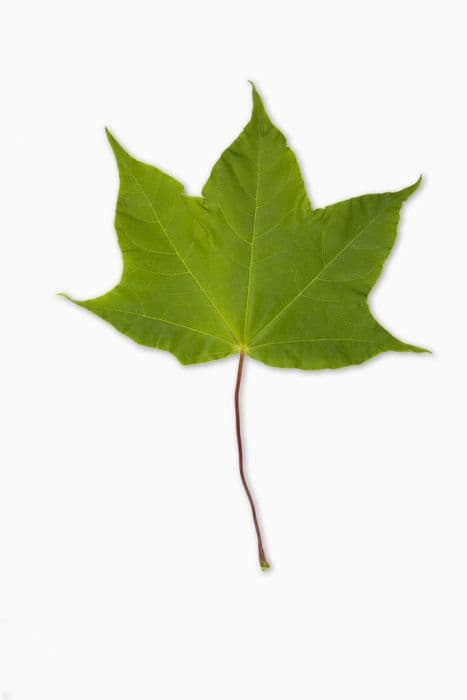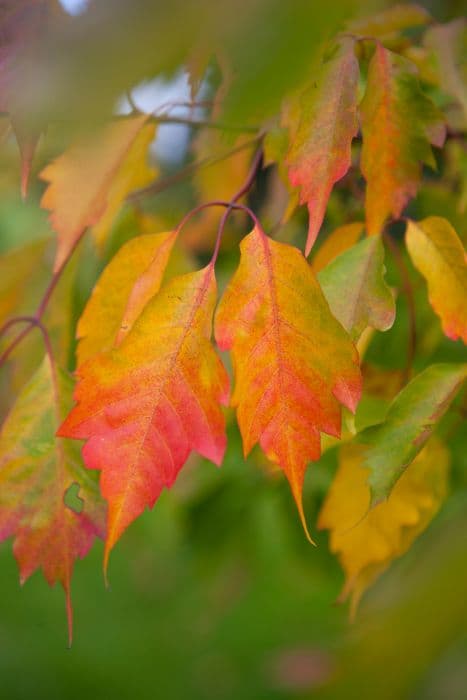Boxelder Maple Acer negundo 'Winter Lightning'

ABOUT
The Acer negundo 'Winter Lightning', commonly known as the box elder, maple ash, or ashleaf maple, is a striking plant recognized for its attractive visual features. It has pinnate leaves which are quite distinctive, typically comprising of several leaflets arranged on each side of a common stalk, giving them a somewhat feathery appearance. The leaves of 'Winter Lightning' are variegated with patterns of green and white, which can add a luminous, almost shimmering quality to the foliage, especially under the interplay of light and shadow in the garden. During different seasons, the box elder displays various colors. In the spring, the new growth may have a pinkish hue, and in fall, the leaves often turn a shade of yellow, which can provide a stark contrast to a waning garden palette. The tree also features clusters of small, inconspicuous flowers that might attract pollinators like bees before the leaves fully emerge. As the season progresses, some forms of this plant may produce winged fruits known as samaras that flutter to the ground like little helicopters. The bark of the 'Winter Lightning' is typically gray or light brown, with a relatively smooth texture when the plant is young and becomes more furrowed and rough as it matures. This textural change adds another layer of visual interest to the plant throughout the year. With its distinct patterns, varied leaf shapes, and seasonally changing colors, the box elder 'Winter Lightning' is a versatile and attractive choice for gardens, capturing the attention of onlookers with its distinctive and dynamic appearance.
About this plant
 Names
NamesFamily
Sapindaceae.
Synonyms
Box Elder, Ashleaf Maple, Manitoba Maple, California Box Elder, Cutleaf Maple, Negundo Maple, Variegated Box Elder.
Common names
Negundo aceroides 'Winter Lightning', Acer negundo variegatum 'Winter Lightning'.
 Toxicity
ToxicityTo humans
The plant commonly known as Boxelder, specifically the Acer negundo 'Winter Lightning' variety, is not typically known for its toxicity to humans. However, like with many plants, individuals may experience allergic reactions or skin irritation upon contact with its sap due to sensitivity or allergy to specific compounds in the plant. Ingestion is generally not associated with severe toxicity, but eating parts of this plant is not recommended, as the safety and effects on humans are not well-documented.
To pets
Boxelder, including the variety Acer negundo 'Winter Lightning', is not widely recognized as a poisonous plant to pets. While it is not commonly associated with serious illness or toxicity in animals, it's still advisable to prevent pets from ingesting this plant. As with humans, there may be a risk of mild gastrointestinal upset or an allergic reaction if a pet were to chew on the leaves, branches, or seeds, but significant toxicity is not commonly reported. If you suspect your pet has ingested parts of this plant and is showing signs of distress, consult a veterinarian.
 Characteristics
CharacteristicsLife cycle
Perennials
Foliage type
Deciduous
Color of leaves
Green
Height
20-30 feet (6-9 meters)
Spread
20-30 feet (6-9 meters)
Plant type
Tree
Hardiness zones
2-10
Native area
North America
Benefits
 General Benefits
General Benefits- Ornamental Value: Acer negundo 'Winter Lightning', commonly known as Boxelder, has attractive foliage and a distinctive form that adds visual interest to landscapes.
- Shade Provider: The canopy of the Boxelder creates a cool, shaded area beneath it, making it a good choice for parks and residential areas.
- Wildlife Habitat: Its seeds serve as food for wildlife, offering nutritional value to birds and small mammals.
- Drought Tolerance: Boxelder is relatively drought-tolerant once established, making it suitable for areas with lower rainfall.
- Windbreak: Its dense foliage can act as a natural windbreak, providing protection for homes and gardens against strong winds.
- Fast Growth: Boxelders are known for their fast growth rate, which can quickly provide privacy and fill in landscaping designs.
- Adaptability: This species can adapt to a wide range of soil types and conditions, making it a versatile choice for different landscapes.
- Seasonal Interest: Boxelder has seasonal changes in foliage color, adding to the year-round interest in a garden or park setting.
 Medical Properties
Medical PropertiesThis plant is not used for medical purposes.
 Air-purifying Qualities
Air-purifying QualitiesThis plant is not specifically known for air purifying qualities.
 Other Uses
Other Uses- Acer negundo 'Winter Lightning', commonly known as boxelder, can be used for woodworking and turning projects as its wood, though considered softer and less durable than some hardwoods, can still be crafted into items like bowls or decorative pieces.
- The branches and twigs of the boxelder may be employed in creating natural dyes, with different plant parts yielding varying shades which can be used in textile and craft applications.
- Its limbs can be fashioned into walking sticks or canes after proper treatment and finishing, providing a lightweight yet sturdy support for hikers and walkers.
- The boxelder's fast-growing nature makes it suitable for use in windbreaks or shelterbelts to protect more vulnerable crops from harsh winds.
- Its sap can be tapped and boiled down to make a syrup similar to maple syrup, although it is much less common and more watery in consistency.
- The lightweight wood of the boxelder is sometimes utilized in the construction of beehives, especially in homemade or artisanal beekeeping practices.
- Cleaned and polished boxelder seeds are occasionally used in jewelry-making or as an addition to ornamental crafts due to their distinctive winged shape.
- The wood is occasionally used for crate or pallet making, where high durability is not the primary concern, and lightweight characteristics are desired.
- In urban forestry, boxelder is sometimes planted for its fast growth and ability to thrive in poor soil conditions, although it is not a first-choice ornamental due to its weak wood and short life span.
- Boxelder wood can be chipped and used as a mulch for gardens, providing a natural method for soil moisture retention and weed control.
Interesting Facts
 Feng Shui
Feng ShuiBoxelder Maple is not used in Feng Shui practice.
 Zodiac Sign Compitability
Zodiac Sign CompitabilityBoxelder Maple is not used in astrology practice.
 Plant Symbolism
Plant Symbolism- Resilience: As a maple species, Acer negundo 'Winter Lightning' often symbolizes resilience, due to its ability to withstand tough conditions and cold climates.
- Adaptability: This plant can thrive in a wide range of soil types and environmental conditions, representing adaptability and flexibility in life.
- Strength: The wood of the Box Elder is known for its toughness; hence the tree can embody physical and mental strength.
- Growth: Maples, in general, are symbols of growth and development, as they typically reach for great heights and spread their branches widely.
 Water
WaterBoxelder 'Winter Lightning' should be watered deeply and thoroughly, ensuring the water reaches the root zone. For newly planted trees, water every 2 to 3 days for the first several weeks, then transition to once a week, providing 1-2 gallons per watering. Established trees require less frequent watering, about once every 2 weeks, depending on weather conditions. During the growing season, it's crucial to maintain consistent moisture, but avoid overwatering to prevent root rot. In winter, reduce water to when the soil is dry to the touch, as the tree is dormant.
 Light
LightBoxelder 'Winter Lightning' thrives best in full to partial sunlight. It is vital to plant it in a spot where it can receive at least six hours of direct sunlight per day. Filtered sunlight or afternoon shade can be beneficial in regions with extremely hot summers.
 Temperature
TemperatureThe ideal temperature range for Boxelder 'Winter Lightning' is between 40°F and 80°F. This variety is fairly cold-hardy and can withstand temperatures as low as -30°F, making it suitable for cooler climates. The tree can also tolerate high temperatures but may require additional watering during heat waves.
 Pruning
PruningBoxelder 'Winter Lightning' requires pruning to maintain its structural integrity, remove any damaged or diseased limbs, and encourage healthy growth. The best time to prune is in late winter or early spring before the sap starts to flow. Prune sparingly, focusing on removing only necessary branches, and aim to do it every 2-3 years or as needed for shaping.
 Cleaning
CleaningAs needed
 Soil
SoilBoxelder 'Winter Lightning' thrives in well-draining soil rich in organic matter with a pH range of 5.5 to 7.5. A good soil mix can be achieved by blending garden soil, compost, and perlite or coarse sand to improve aeration and drainage. Mulching can help retain moisture and regulate soil temperature.
 Repotting
RepottingBoxelder 'Winter Lightning' typically requires repotting every 2 to 3 years as it can grow quite rapidly. Choose a larger pot to allow for growth and refresh the soil mix to replenish nutrients.
 Humidity & Misting
Humidity & MistingBoxelder 'Winter Lightning' is adaptable to a wide range of humidity levels but prefers average household humidity. It can tolerate some dryness but will benefit from increased humidity in very dry environments.
 Suitable locations
Suitable locationsIndoor
Place Boxelder 'Winter Lightning' near a bright window for best growth.
Outdoor
Plant in a sunny spot with space for roots to spread.
Hardiness zone
3-9 USDA
 Life cycle
Life cycleBoxelder Maple 'Winter Lightning' begins its life cycle when the wind-dispersed samara (seed) lands in suitable soil and conditions are optimal for germination, typically in spring or early summer. Once germinated, the seedling grows rapidly, establishing a root system and producing its first set of leaves. Throughout the following years, it enters a vegetative stage where it develops a woody trunk, branches, and a canopy of compound leaves, becoming a young tree. As it matures, the tree reaches its reproductive stage, flowering in early spring with inconspicuous yellow-green flowers that are followed by the development of its characteristic winged samaras. These seeds are then released, completing the reproductive cycle. The tree can live for several decades, possibly reaching significant heights and widths before eventually succumbing to old age, environmental stress, or disease, at which point it will decompose and return nutrients to the soil.
 Propogation
PropogationPropogation time
Late Winter to Spring
Acer negundo 'Winter Lightning', commonly known as the Box Elder 'Winter Lightning', is most popularly propagated using the cutting method. The best time to take cuttings for propagation is during the late spring to early summer when the plant's growth is most vigorous. To propagate the Box Elder 'Winter Lightning' by cuttings, select a healthy, semi-hardwood branch that is about 6 to 8 inches (15 to 20 centimeters) long, with several leaf nodes. Remove the leaves from the lower half of the cutting and dip the cut end into a rooting hormone to encourage root development. Then, plant the cutting in a well-draining potting mix, making sure to keep the soil consistently moist but not waterlogged. Place the pot in a warm location with indirect light and maintain a high humidity environment, often by covering the pot with a plastic bag or using a propagation dome until roots have firmly established. After the roots have developed, which may take several weeks, the rooted cutting can be gradually acclimated to less humid conditions and eventually transplanted into the garden.







